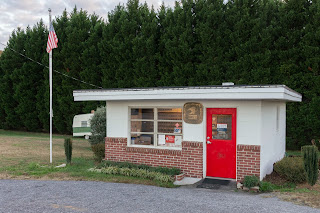Whitestone Springs part 1: Visiting the spring and hotel
 |
| from the July, 23rd 1902 edition of the Anderson Intelligencer |
Whitestone Spring is now part of Croft State Park on land that was a military camp from 1940-1947. The official way to get there is to hike there from within the park, but there's also an old road you can follow from Whitestone Spring Road, located on the park's eastern edge. I went the official way, so the park gets their admission fee and because I haven't been hiking inside this part of the park before.
I arrived at Croft State Park later than I planned. I picked up a paper map at the office and headed down the road to the trailhead for Fosters Mill Trail Loop.
The ground was soft and muddy in spots. The first thing I noticed were all the horse shoe prints.
The second thing I noticed was all the horse poo. One spot on the trail had four or five mounds in a row right in the middle of the trail. Ick! The good news is the further down the trail I hiked the less horse poo I had to dodge. The bad news is I'd have to dodge them all over again on the way back.
The rest of the way was mostly unremarkable.
I knew I was getting close when began spotting ruins of the water bottling plant.
It wasn't long before I made it to the spring itself.
The spring still works, but the water doesn't shoot as high as it did in the newspaper accounts I had read.
Also, a basin I read about afterward is no longer there.The spring was once known as Kirby Springs. J. T. Harris bought the spring and renamed it to White Stone Springs. The spring water was bottled and marketed as White Stone Lithia Water and claimed the ability to cure just about any ailment.
The three story brick hotel was modern by contemporary standards featuring electricity and steam heat. The hotel burned down in March 1906, and was never rebuilt. The spring water bottling business continued until at least the mid 1920s.
I learned from my pre-adventure research the hotel was located on one of the surrounding hills. Several obvious paths presented themselves.
The rightmost choice was a path leading straight up a hill. I thought it unlikely the hotel was up there, but I wanted to be thorough so up I went. I did find a small pile of brick rubble up there so something was there, but no hotel.
The middle choice was a wide path that led me toward Whitestone Road according to the map I had stored on my tablet combined with the GPS trace my tablet recorded. This must have been the road that led to the hotel.
The last choice was a path curving around the side of a hill. This one looked more like it.
When I found a rusted out pail, I decided I must be headed the right way.
I left the path and searched the area at the top of the hill. I found some brick rubble and broken glass.
The area did look like a place where a hotel could have been situated. Later research would confirm I had found the spot. I headed back to the path to see what I could find, and I wasn't disappointed when I found the ruins of a small brick building.
I kept going until the path seemed to end. I took that as my cue to head back. The shadows were getting too long for comfort, and I wanted to visit the town of White Stone before it got dark.
I used my GPS traces from the trip to add the location of Whitestone Springs, the trails to get there, and the paths around the spring to OpenStreetMap for everyone's benefit:
View Larger Map
With the sun now setting, I arrived at White Stone, SC with just enough light to photograph two historic buildings in the town. The rather small post office:
And the school building, erected in 1912:
Unfortunately, the trees made it impossible to get a good photo of the front from any angle.
With that, I called it a day.
My photos from the Whitestone Springs visit are in an album at Google Photos, and in a set at Flickr. My photos from White Stone, SC are in a different album at Google Photos, and in a different set at Flickr.
In the next part, I'll go over the more interesting newspaper articles I found about the spring and hotel from the Chronicling America and Google News archives, including a drama involving a theft, an accusation, a lawsuit, and ending with a sudden death.






















.jpg)
If you had gone behind the Whitestone school you would have seen the remnants of an old baseball field. A long set of concrete bleachers still line the right field line of the ballfield. The company I worked for and recently retired from tried to rehab the field about 10 years ago but; with no demand for use rhett project died. The bleachers were cleaned up (although the trees growing up in them remained) and the field itself was cleared of overgrowth. I would vessels now no evidence of this effort remain.
ReplyDeleteHas anyone been to the slave graveyard near Camp Croft?
ReplyDeleteThere actually about eight graveyards associated with Croft. I think four are in the park and the others are in the surrounding areas. Several families were uprooted when the government bought the land. The second grave yard on the way in to the park was used as recently as the 60's or 70's I believe. It's been a few years since I was there. There is an old church at that graveyard. Thank you for this I had never heard of Whitestone Springs. Very neat history.
ReplyDelete